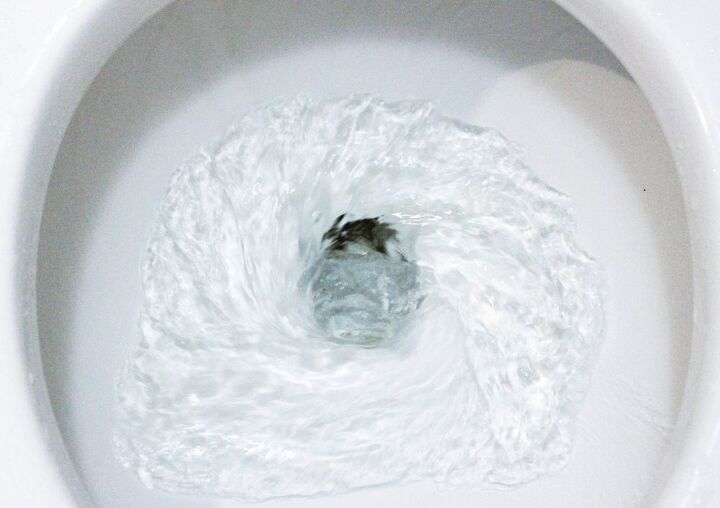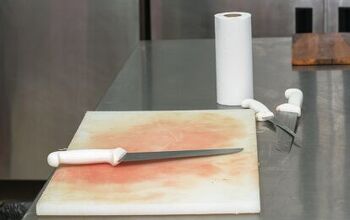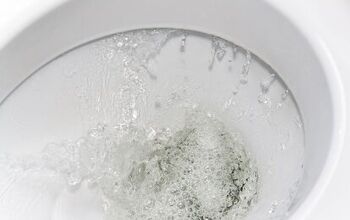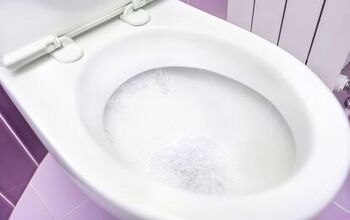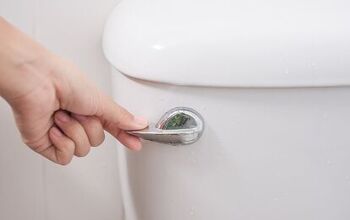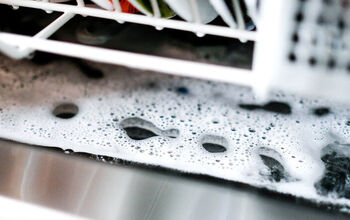Toilet Swirls But Won't Flush: Possible Causes & How to Fix

Toilets are in every home, but they are hardly talked about until something goes wrong. Toilet issues, however, are more common than you might think. In fact, one survey suggests that 28 million Americans have a toilet that clogs every month. This begs the question – what can be done when you have a toilet that swirls but won’t flush?
If your toilet swirls but won’t flush there is a strong possibility your flush tank is not filling properly. Open the lid on your tank and see if water comes up to the water line on the tank. If the tank does not fill properly you should check the flapper, float ball, lift chain and look for possible clogs.
Toilets, like all major household appliances, become less effective over the years. After some time you may try to flush a toilet and notice it swirls but doesn’t flush. This problem can be highly frustrating, and it often requires immediate attention. Luckily, there are only so many possible reasons for this issue, and most of them can be fixed easily.
Do You Need to Hire a Plumber?
Get free, zero-commitment quotes from pro contractors near you.

Five Reasons Your Toilet Swirls But Won’t Flush
For every “successful flush,” water must be delivered quickly to the toilet. But that may never happen if the water level is too low in the toilet tank. The toilet will lack the required water once you flush. There are three main reasons your water may be too low.
If low water is not the issue, the toilet is likely clogged. There are two types of clogs that can cause your toilet to swirl but not flush.
Your Tank Won’t Fill Properly
Manufacturers indicate the optimal water level with a mark inside the tank. That line is about an inch under the top of the overflow tube. With water below that level, it’s always a struggle to get your waste out to the appropriate channel.
Your tank may not fill properly when you go about adjusting the water level to save water. If this is the case, you can adjust it as needed to ensure a quality flush. In other situations, one or more components of your toilet may not be functioning properly. In order to identify and fix the problem you must investigate the three usual suspects.
Float Ball Needs Adjusting
Your toilet bowl should have a float ball. This ball is designed to ensure that your tank fills up to the proper level each time it flushes. If your float ball is too low, then your tank will not fill with enough water to flush it. This will cause your toilet to swirl but not flush. To solve this problem you will need to adjust the float ball following a few simple steps.
Step One: Remove The Lid From Your Toilet Tank
This lid should be located behind the bowl itself. Carefully set it aside.
Step Two: Investigate Current Water Level In Tank
In order to know the water level is the issue you should check the water line on the toilet. If there is no water line then find the overflow tube, as the water should reach one inch beneath the overflow tube.
Step Three: Shut Off Water Valve and Empty Tank
Find the water valve behind the toilet and shut it off. Flush the toilet until the tank is emptied.
Step Four: Check For Issues With Float Ball
See if there is any problem with the float ball. Perhaps it is damaged and needs to be fixed or replaced. Then, check the level of the float bowl to ensure it needs adjusting.
Step Five: Make Necessary Adjustments
Use a screwdriver to turn the screw on the fill valve in the clockwise direction in order to increase the fill level in your tank.
Step Six: Turn On Water Valve
Turn on the water valve and test your toilet to ensure the water level is now satisfactory.
Broken Flapper
The flapper is the rubber device that prevents the water in the flush tank from flowing into the toilet. The flapper is connected to the lift chain. When you flush the toilet, the chain lifts the chain and allows the water to release into the toilet.
Just like with any rubber accessory, your toilet flapper will wear and break down over time. If your flapper begins to deteriorate it may no longer act as a perfect seal between your tank and the toilet. This can cause a leak, which will also cause the tank to lose water.
To fix a broken toiler flapper, the easiest and only way to fix a broken flapper is to get a new one. They are relatively inexpensive and easy to install. They should be available for purchase at your local hardware store.
Issue With Lift Chain
The lift chain that connects the flapper to lift it when you flush may also be the reason your toilet is not filling up properly. Over time this chain may become slack, preventing it from lifting effectively. This can cause your toilet to swirl but not flush.
Quick Fix: Re-hook to another hole. Each lift chain should have multiple anchor points for you to hook it to. You need to find a hole that is convenient from the flush lever and re-hook it. The chain should maintain ½ inch of slack as a rule of thumb.
Clogged Toilet
A clogged toilet is another reason your toilet is swirling but not flushing. Drainpipe clogs can be quite common and will prevent your toilet from flushing. There are other types of clogs as well, like jet hole clogs, that can prevent your toilet from flushing. Luckily, both types of clogs have fixes you can often do yourself.
Jet Holes Clogged
Jet holes are right under the lip in your toilet bowl. These jets allow water to flow into the toilet bowl when you flush. Sometimes minerals or other properties in your water can build up in these holes and cause them to clog. If these holes are clogged, you may lose the amount of water needed to flush.
If no water is streaming down the sides of the bowl, that’s a hint that your holes are clogged or blocked. Another sign that these holes are clogged is if the water tends to stream down diagonally.
Tip: Examine the inlet holes by holding a mirror under the rim of your toilet and flushing at the same time.
How To Unclog Your Jet Holes
The best DIY fix to try and remove the clogs in your jet holes involves adding heated vinegar to your overflow tube.
- Take about 10-20 ounces of white vinegar and heat to at least 120 degrees.
- Pour the vinegar down the overflow tube.
- Allow it to sit for an hour. Be sure you do not flush the toilet during this time.
- Use an Allen wrench to clear the inlet holes.If your jet holes are becoming clogged fairly frequently then you may want to invest in a water softener system. These clogs can be greatly reduced by softening and purifying the water that flows through the toilet.
Drainpipe Clogged
Most adults have experienced a clogged toilet at least once in life. When you use too much toilet paper or flush a paper down the toilet, it can clog the pipe. That will make further flushing a big challenge. The usual culprits are sanitary napkins.
Drainpipe clogs can vary in their severity. More simple clogs can be easily broken up and cleared using a nearby plunger. Some clogs, however, may have built up over a long period of time. These more advanced clogs may require an auger, or even the assistance of a professional.
Plunger Method
Most homes have a plunger. This is because a plunger is often the easiest fix when you have a clogged toilet drain. When using a plunger be sure the plunger covers the entire mouth of your toilet while also creating suction. If your best efforts with a plunger are unsuccessful, you should next try calling a professional with an auger.
Call In A Professional With An Auger
An auger is a flexible metal pipe device that can find its way deep into your drain pipe and break up a major clog. These devices are usually owned by plumbers and should not be operated by someone who is not a plumbing expert.
If the problem persists after your effort, then you may be grappling with a clog in the toilet flange or drain. You’ll require the service of a contractor that will not take too long to get the job done.
Poorly Designed Toilet Drainpipe
If the drainpipe is poorly designed or installed, then you will always experience a slow flush. Your toilet should have a downward slope to allow the wastewater flow with ease and quickly down the bowl. Without this proper arrangement in your drain, the pipe will get stuck because of the pool of water.
Bubbles in the toilet bowl water are an indication that the drainpipe has an issue. You need to fix this poorly designed drainpipe, so it does not snowball into a bigger problem. The solution is within your grasp, but likely out of your expertise.
Contact a professional plumber. You may not be able to fix this by yourself, as it is an involved repair and diagnosis. You need to call a professional plumber to inspect the drainpipe, which may lead to a redesign.
Do You Need to Hire a Plumber?
Get free, zero-commitment quotes from pro contractors near you.

What Did We Learn?
When you notice that your toilet is swirling but not flushing properly, there is likely an issue with the water tank, or possibly a clog. Flush tank issues are usually easy to identify and repair on your own, regardless of if the issue is flapper, float ball or the lift chain.
Your toilet may also be clogged. If it is clogged, you should identify where the clog is exactly and what caused it before you find the proper remedy to remove the clog. If the problem seems too complex, or you cannot locate the exact issue, you don’t have to figure it out by yourself—call on professionals to flush the problem down for good.

We are a team of passionate homeowners, home improvement pros, and DIY enthusiasts who enjoy sharing home improvement, housekeeping, decorating, and more with other homeowners! Whether you're looking for a step-by-step guide on fixing an appliance or the cost of installing a fence, we've here to help.
More by Upgraded Home Team



